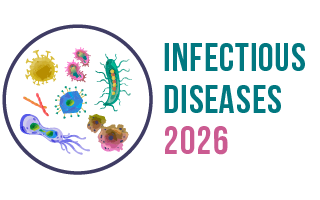4th International Conference on
Infectious Diseases
September 09-10, 2026 | Barcelona, Spain

Infectious Diseases 2026

Woolcock Institute of Medical Research, Vietnam
Abstract:
This study aimed to assess the clinical utility of blood lactate-to-bicarbonate (L/B) ratio, as a prognostic factor for 28-day in-hospital mortality in children with dengue shock syndrome (DSS). This single-center retrospective study was conducted at a tertiary children hospital in southern Vietnam from 2013 to mid-2022. Prognostic models for DSS mortality were developed, using a predefined set of covariates in the first 24 hours of PICU admission. Area under the curves (AUCs), multivariable logistic and LASSO regressions, bootstrapping and calibration slope were performed. A total of 492 children with DSS were included in the analysis, and 26 (5.3%) patients died. The predictive values for DSS mortality, regarding lactate showing AUC 0.876 (95% CI, 0.807-0.944), and that of L/B ratio 0.867 (95% CI, 0.80-0.934) (P-values of both biomarkers < .001). The optimal cutoff point of the L/B ratio was 0.25, while that of lactate was 4.2 mmol/L. The multivariable model showed significant clinical predictors of DSS fatality including severe bleeding, cumulative amount of fluid infused and vasoactive-inotropic score (> 30) in the first 24 hours of PICU admission. Combined with the identified clinical predictors, the L/B ratio yielded higher prognostic values (OR = 8.66, 95% CI: 1.96-38.3; P < .01) than the lactate-based model (OR = 1.35, 95% CI, 1.15-1.58; P < .001). Both the L/B and lactate models showed similarly good performances. Considering the L/B ratio has a better prognostic value than lactate-based model, it is proposed as a potential prognostic biomarker in clinical use for predicting 28-day dengue-associated mortality.
Biography:
Thanh Nguyen Tat , a senior clinical researcher from the Woolcock Institute of Medical Research, Vietnam. He is a Co-chief investigator in the project, “Advanced Dengue Prognosis and Treatment” in Vietnam. He have published 25 articles and served as an editorial board member of several journals.
